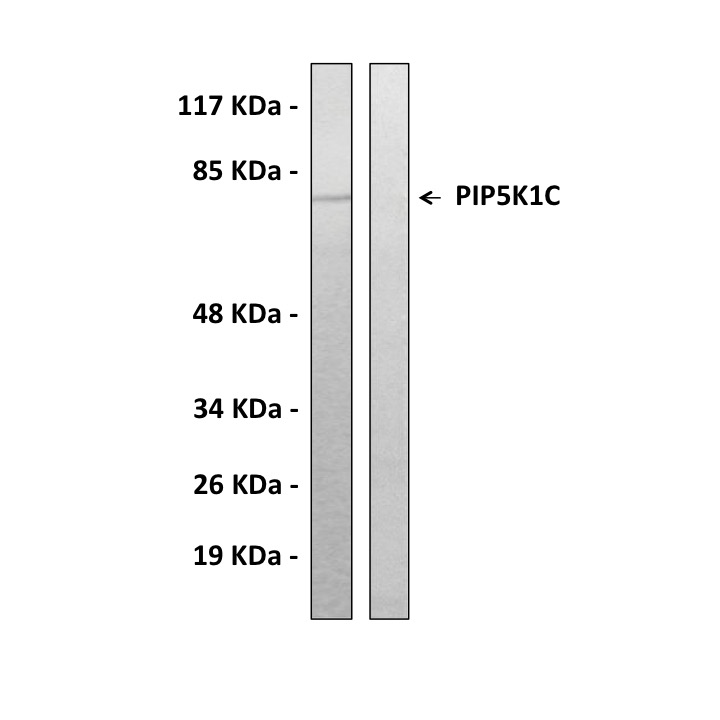Product Sheet CG1436
Description
BACKGROUND PtdIns (4,5)P2 is positioned at the crossroads of many of these signaling cascades, as it may be metabolized by phospholipase C to generate Ins (1,4,5)P3 and 1,2-diacylglycerol, further phosphorylated at the 3-position of the inositol ring by PI 3-kinase to generate PtdIns (3,4,5)P3 or used directly as a messenger molecule by binding to proteins containing PH (pleckstrin homology), PX (phox homology), FERM (band 4.1, ezrin, radixin, moesin) or comparable domains. PtdIns (4,5) P2 seems to be synthesized in a highly site-specific manner at distinct subcellular locales where it is directly utilized as a signaling molecule, thereby modulating the activity, conformation, assembly or disassembly of proteins at these sites. The spatial and temporal metabolism of PtdIns ( 4,5)P2 has emerged as a crucial regulator of multiple cellular processes, including actin reorganization, focal-adhesion dynamics, endocytosis and exocytosis, nuclear signaling pathways and gene expression.1
Most cellular PtdIns (4,5)P2 generation is fulfilled by the alpha, beta and gamma isoforms of the type I PIPKs (PtdIns4P 5-kinases) (also called “PIP5K1A,” “PIP5K1B,” and “PIP5K1C,” respectively), although PIP5K types II enzymes also synthesize PtdIns (4,5)P2. Of these three homologues, PIP5K1C/PIP5KIgamma is thought to be the main enzyme responsible for PtdIns (4,5)P2 synthesis in the brain, which plays important role in synaptic transmission.2 Although retaining high homology within the lipid kinase domain, each isoform exhibits a distinct subcellular localization pattern and functional specificity. It is believed that the N- and C-terminal sequence divergence of each PIP5KI isoform contributes to this diversity in targeting and function. PIP5KIalpha participates in both nuclear and cytoplasmic PtdIns (4,5)P2 generation, where it has been implicated in the regulation of RNA polyadenlyation machinery and growth-factor-induced reorganization of the cytoskeletal superstructure. The cellular roles of PIP5KIbeta are less defined, but a function for PIP5KIbeta in actin assembly and endocytosis has been suggested. PIP5K1C/PIP5KIgamma is a workhorse for site-specific PtdIns (4,5)P2 generation in a plethora of cytoplasmic processes.3 PIP5K1C/PIP5KIgamma is a fundamental regulator of the assembly and disassembly of sites of cell-matrix and cell–cell interaction termed focal adhesions and adherens junctions respectively. Importantly, the human PIP5K1C/PIP5KIgamma is known to encode at least two alternative splice variants, PIPKIgamma640 and PIPKIgamma668. This 28-amino-acid extension at C-terminus has been demonstrated to confer specific subcellular targeting and function on PIP5K1C/PIP5KIgamma 668, where it consequently regulates focal adhesion dynamics, EGF-stimulated directional migration, basolateral targeting of E-cadherin, and endocytosis of the transferrin receptor. Aside from mediating specific protein–protein interactions, this extension also affords several methods of regulating PIP5K1C/PIP5KIgamma668 activity, as it is tyrosine- and serine-phosphorylated by Src and cyclin-dependent kinase respectively. In addition, PIP5K1C/PIP5KIgamma can be directly phosphorylated by EGFR. In the absence of a specific C-terminal extension, PIP5K1C/PIP5KIgamma 640 also plays a specific cellular role, as it is the major contributor of the PtdIns (4,5)P2 utilized in G-protein-coupled-receptor-mediated Ins (1,4,5)P3 generation.4 PIP5K1C/PIP5KIgamma deficiency affects various signaling pathways including PI3-kinase pathway, which leads to phosphorylation of PtdIns(4,5)P2 and to generation of PtdIns (3,4,5)P3. PI3-kinase catalyzed synthesis of PtdIns (3,4,5)P3 was diminished in the LCCS3 patents and PIP5Kgamma(-/-) mice as a result of reduced synthesis of its precursor, PtdIns (4,5)P2.5
REFERENCES
1. Di Paolo, G. et al: Nature 431:415-22, 2004
2. Akiba, Y. et al: Gene Exp. Patterns 1:123-33, 2002
3. van den Bout, I. & Divecha, N.: J. Cell Sci. 122:3837-50, 2009
4. Schill, N.J. & Anderson, R.A. : Biochem. J. 422(Pt.3) :473-82, 2009
5. Narkis, G. et al: Am. J. Hu. Genet. 81:530-9, 2007
2. Akiba, Y. et al: Gene Exp. Patterns 1:123-33, 2002
3. van den Bout, I. & Divecha, N.: J. Cell Sci. 122:3837-50, 2009
4. Schill, N.J. & Anderson, R.A. : Biochem. J. 422(Pt.3) :473-82, 2009
5. Narkis, G. et al: Am. J. Hu. Genet. 81:530-9, 2007
Products are for research use only. They are not intended for human, animal, or diagnostic applications.
Details
Cat.No.: | CG1436 |
Antigen: | Synthesized peptide derived from human PIP5K1C |
Isotype: | Rabbit IgG |
Species & predicted species cross- reactivity ( ): | Human |
Applications & Suggested starting dilutions:* | WB 1:500-1:1000 IP n/d IHC n/d ICC n/d FACS n/d ELISA 1:20000 |
Predicted Molecular Weight of protein: | 73 kDa |
Specificity/Sensitivity: | Detects endogenous PIP5K1C proteins without cross-reactivity with other family members. |
Storage: | Store at -20°C, 4°C for frequent use. Avoid repeated freeze-thaw cycles. |
*Optimal working dilutions must be determined by end user.
Products
| Product | Size | CAT.# | Price | Quantity |
|---|---|---|---|---|
| Rabbit PIP5K1C Antibody: PIP5K1C Antibody produced in rabbit | Size: 100 ul | CAT.#: CG1436 | Price: $384.00 |

